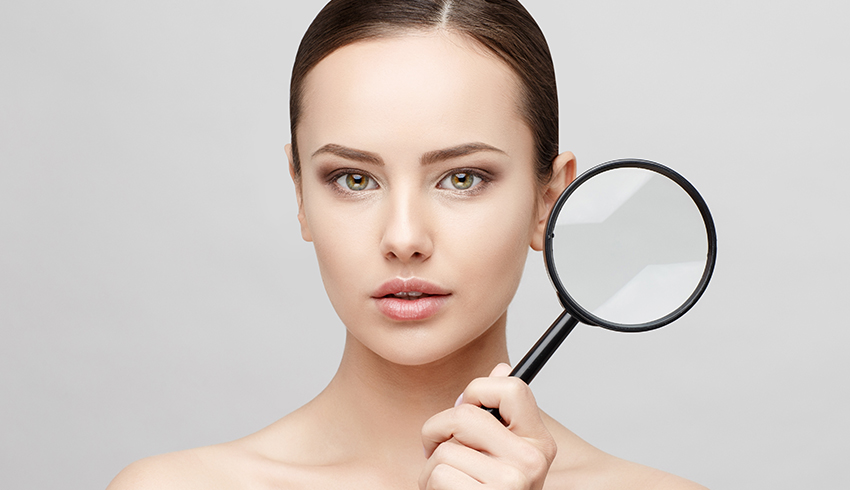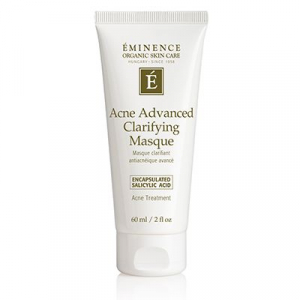
The Truth About Acne-Prone Skin
Does chocolate cause breakouts? Are blackheads dirt? Will moisturizer clog your pores? What you think you know about adult acne is probably less fact, more fiction. And, when it comes to treating acne, it helps to understand the difference. Ready to get to the bottom of things? Here are ten myths about breakouts - busted.
Myth #1: Acne Is A Teenage Problem
The most common acne myth is that acne is a teenage problem. While it’s true that most teens (close to 85%) battle breakouts, pimples can continue to pop up - and even appear for the first time - in adulthood. In fact, this clinical study reports that 54% of women and 40% of men reported having some form of acne. While the severity and symptoms of adult-onset acne vary, acne that develops past adolescence is typically caused by genetics and hormones, and aggravated by stress.
Myth #2: Junk Food Causes Breakouts
Contrary to popular belief, junk food does not cause pimples (cue collective hallelujah). But, don’t be too quick to scoop up that second slice of pizza. While research shows no direct link between junk food and acne, the consumption of fatty and sugary foods can still have a negative impact on your skin. As dermatologist Ava Shamban explains to HuffPost: “When people fill up on chocolate and other high-caloric and fatty foods, they leave little room to eat a balanced and well rounded diet, which is needed for healthy skin. So it can be the lack of needed nutrients, rather than the [junk food] itself, which supports the proliferation of acne.” What to do? Registered dietitian Annie Tsang says, that though more research is needed to confirm a connection between healthy eating and clear skin: “plant-based foods and foods containing healthy fatty acids (omega-3s), such as salmon and rainbow trout, are high in anti-inflammatory properties which can be beneficial to our skin.” Cutting out foods like refined carbohydrates, sugars and dairy may not make blemishes vanish overnight, but swapping in good-for-you alternatives has the potential to improve your skin’s health over time.
What to do? Registered dietitian Annie Tsang says, that though more research is needed to confirm a connection between healthy eating and clear skin: “plant-based foods and foods containing healthy fatty acids (omega-3s), such as salmon and rainbow trout, are high in anti-inflammatory properties which can be beneficial to our skin.” Cutting out foods like refined carbohydrates, sugars and dairy may not make blemishes vanish overnight, but swapping in good-for-you alternatives has the potential to improve your skin’s health over time.
Myth #3: Problem Skin Is Dirty Skin
Repeat after us: Acne-prone skin is not dirty skin. In fact, hygiene and breakouts are completely unrelated. According to Health: “Skin cell turnover is a natural process that pushes oil and debris out of your pores, keeping them clean. When that doesn’t happen fast enough, your pores collect a backlog of oil, skin debris and protein. Dirt is not part of the equation.” Rather, acne results when this backlog combines with bacteria, triggering infection and inflammation.
A related misconception is that acne can be eradicated by keeping skin squeaky clean. But believe it or not, there is such thing as cleansing too much. While we’re advocates of a clean complexion, overwashing and using harsh cleansers can contribute to the breakdown of your skin’s natural oils. This dehydrates the skin, which overcompensates by producing even more sebum. The result is - you guessed it - clogged pores and more breakouts.
Myth #4: Oily Skin Doesn’t Need Moisturizer
If your skin is acne-prone, you may balk at the mention of moisturizer. But trust us, even oily skin needs hydration and moisture. Dr. Anjali Mahto tells Cosmopolitan: “Moisturizing the skin maintains the integrity of barrier function and is vital for good skin health. Even oily skin needs moisturizing as excess oils do not equate to effective skin hydration.” When skin is dehydrated, it compensates by producing more oil which leads to more breakouts. A healthy moisture barrier not only locks in moisture but keeps out impurities and irritants that can make problem skin worse.
You now know moisturizing is a key step to any acne skin care routine - but are all moisturizers created equal? The short answer: no. Rich moisturizers can be overkill for an oily complexion. Instead, opt for a lightweight hydrator that won’t bog down your pores. Our recommendation is the new Acne Advanced Clarifying Hydrator which uses zinc hyaluronate and lotus extract to keep skin hydrated and shine-free.
Myth #5: The Stronger The Acne Treatment, The Better It Works
When it comes to acne treatments, stronger isn’t necessarily better. Products that promise to dry out pimples often include harsh chemical additives that over strip and irritate an already inflamed complexion. Women’s Health says: “Many potent acne-blasting products strip natural oils from the skin. So while heavy-duty formulas may make the skin feel squeaky-clean at first, they’re actually skimming off what your skin naturally needs and can cause pores to panic. They then produce even more oil and therefore, worsen your acne in the long run.”
Our organic solution is the Acne Advanced Treatment System, which uses natural and botanical actives to treat acne and prevent future breakouts. Dermatologist Renata Jenkin says: “While acne sometimes requires strong ingredients to combat breakouts, acneic skin is often sensitive. The Acne Advanced System by Eminence Organic Skin Care delivers proven results for patients who are seeking an effective natural treatment for their acne.”

Myth #6: The Black In Blackheads Is Dirt
Blackheads aren’t at all related to the cleanliness of your skin. In fact, these small dark spots only differ slightly from whiteheads. The medical term for blackhead is “open comedo” and refers to a dilated hair follicle filled with sebum, dead skin cells and bacteria that, unlike a whitehead, is left uncovered. When sebum is exposed to air, a chemical process called oxidation occurs which causes it to darken.
Blackheads are best treated with topical remedies containing ingredients like salicylic acid that exfoliate skin and soften sebum. Salicylic acid is an oil-soluble BHA that is able to penetrate blocked pores and dissolve the paste-like mixture of sebum and dead skin that leads to blackheads. In addition to being an incredibly effective acne-fighter, salicylic acid has anti-inflammatory properties that reduce redness and calm acne-prone skin.
Myth #7: Applying A Spot Treatment Is Enough
When battling moderate to severe acne, applying the odd spot treatment isn’t going to do the trick. Dr. Joshua Zeichner tells Allure: “To keep a clear face, you need to treat the pimples you have, as well as those hiding under the skin that have not yet come to the surface. If you treat only the big pimples, you won’t prevent any new ones from popping up, and you will always be playing catch-up, rather than keeping your face clear.”
Dermatologists recommend using products that not only tackle existing pimples but also prevent new ones from forming. The products in Eminence Organics Acne Advanced 3-Step Treatment System are infused with natural and botanical actives and an encapsulated salicylic acid to both treat and prevent breakouts. Together, they keep skin clearer for longer.
Myth #8: Body Acne Is The Same As Face Acne
If you experience acne vulgaris on your face, it is likely that you’ve noticed pimples popping up on your neck, chest and back as well. These body breakouts are caused by the same triggers as facial acne, but they can be more challenging to treat. Dr. Valerie Goldburt tells Allure: “The breakouts on your chest and back tend to be a little different than the acne on your face. They’re technically called folliculitis, which is when the hair follicle becomes infected. However, it looks the same as facial acne and can be treated with the same products and ingredients.” One of the troubles with body acne is that the hair follicles (pores) are spaced further apart and the skin tends to be more tough. This can make it more difficult for topical products to penetrate the epidermis and work as quickly as they do on the face. Here are a few tips to keep in mind to improve the look of body breakouts:
One of the troubles with body acne is that the hair follicles (pores) are spaced further apart and the skin tends to be more tough. This can make it more difficult for topical products to penetrate the epidermis and work as quickly as they do on the face. Here are a few tips to keep in mind to improve the look of body breakouts:
- Shower immediately after working out and always change into a fresh set of clothes
- Use products that contain salicylic acid - like Acne Advanced Clarifying Masque - to spot treat body blemishes
- Avoid benzoyl peroxide which can be harsh on skin and bleach fabric
Myth #9: Your Pores Can Open And Close
We hate to break it to you, but there is no way to close your pores completely. In fact, open pores play a key role in your skin’s health, releasing the sweat and sebum that keep it cool and lubricated. That said, when you’re already battling acne, large pores can feel like an unnecessary burden.
The good news: Pores can be made to look smaller. Your pores enlarge when oil and dead skin build up and put pressure on the pore opening, causing it to stretch. To “shrink” them down to size, you need to clear that congestion. According to Healthline: “Often, when people say they wish to open their pores, what they’re referring to is a deep cleaning to remove excess oil and debris. This may make open pores look as if they’ve shrunk or closed.” One of the best ways to minimize large pores is with a professional salicylic acid peel performed by a licensed esthetician.
Myth #10: Acne Is Skin Deep
Acne goes more than skin deep. Studies show that persistent acne has mental and emotional effects that impact confidence, wellbeing and self-esteem. According to the American Academy of Dermatology, researchers have found connections between acne and the development of depression, anxiety, low self-esteem, poor self-image and decreased quality of life. Amy Wechsler, a board-certified dermatologist and psychiatrist tells Allure: “Acne negatively affects self-esteem and can lead to anxiety and depression. Self-care often suffers, and patients with acne often withdraw from social and work activities, don’t go on dates and don’t try for better jobs.” Watch our #AcneAdvancedStories to learn how Vanessa, Nicola and Christina struggled with - and overcame - acne:
What acne myths have you debunked? Do you have your own #AcneAdvancedStories to share? Let us know in the comments below - and join the conversation on Facebook | Instagram | Twitter | Pinterest | LinkedIn | YouTube.